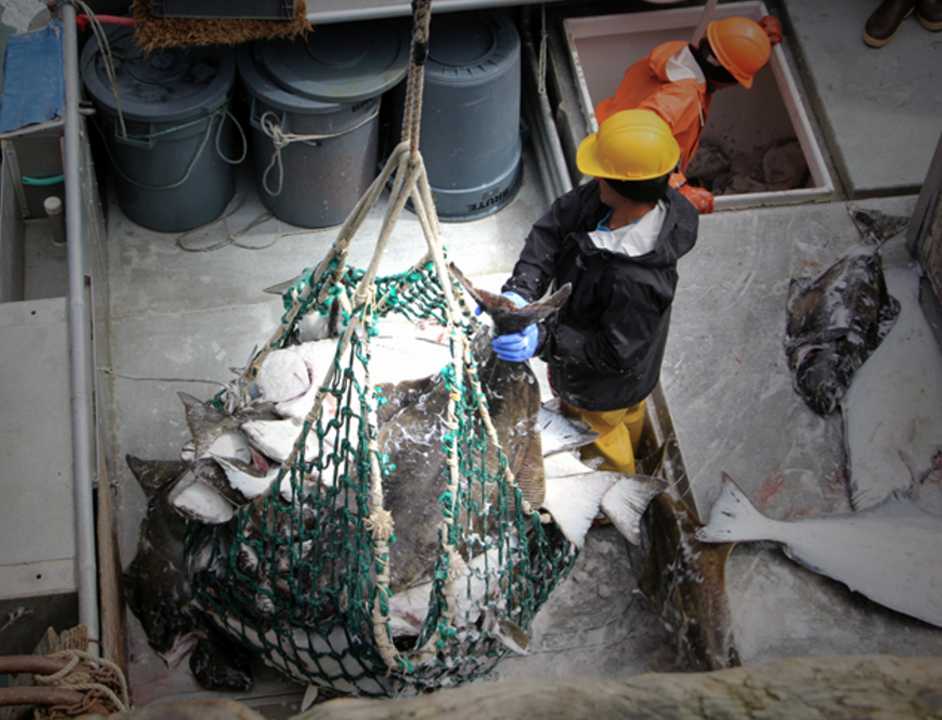ANCHORAGE — Stocks have stabilized and bycatch is as low as it’s been since 1960, however the halibut quota for next year will edge down after being raised for the first time in years in 2016.
The International Pacific Halibut Commission held its interim meeting in Seattle Tuesday and Wednesday to review the 2016 catch, status of the stock, and to recommend how much halibut fishermen will be able to take in 2017.
Overall, biologists and managers gave a view of a responsible group of users responding well to a trough in the historical ups and downs of halibut abundance, which has flattened after a decade of downward movement.
IPHC biologist Dr. Ian Stewart painted a more secure picture of halibut than the last two years have seen, emphasizing decreased bycatch and a firm outlook for abundance.
“I think it’s pretty clear that we’ve seen the stock stabilize,” Stewart said.
The commission set a recommendation, called the blue line, of 26.1 million pounds, a slight decrease from last year’s blue line of 26.7 million pounds.
The commission will meet again in January to adopt official limits, which may or may not match the blue line. In 2016, the IPHC adopted official limits of more than 3 million pounds beyond that of the blue line.
Fishermen have, for the most part, been responsible in the pursuit. Commercial halibut fisheries in each of the regulatory areas in Alaska collectively caught 3 percent less than their catch limit.
Guided anglers in Southeast Alaska, or Area 2C, caught 13 percent less than their limit, while the guided anglers in Southcentral Alaska went over their allocation by 8 percent.
Reports detailed that overall landings have been fairly static over the last three years, with a total landing of 32.2 million pounds in 2016. Only Area 2A, the West Coast between California and Washington, went over the combined catch limit for all user groups, by 1 percent.
Halibut has persisted as a fisheries politics hot button as more users than ever split the resource.
Commercial halibut fishermen share the harvest with guided charter vessels, non-guided recreational fishermen, subsistence and non-halibut fishermen who incidentally catch halibut in the process of fishing their own quota, known as bycatch.
The overall removals are more divided among user groups than they have ever been, Stewart said, with only 60 percent of removals going to the directed commercial fishery, while guided recreational fisheries and bycatch each made for 17 percent apiece. The remaining halibut was divided amongst subsistence users.
Notably, the hotly argued issue around halibut bycatch could ease as the bycatch rates for groundfish trawlers drop. Since 2014, bycatch has dropped nearly 2 million pounds.
“We’ve seen a substantial reduction in bycatch from almost 9 million pounds in 2014 to just over 7 million pounds in 2016, Stewart said. “That pattern in 4CDE (Central Bering Sea) is what’s driving the overall reduction in bycatch.”
Regulatory Area 4CDE became the focus of IPHC and North Pacific Fishery Management Council action in 2014 over the amount of bycatch taken in that area by groundfish trawlers.
The directed halibut fishermen in the Central Bering Sea begged the council to lower bycatch caps for the trawlers so more halibut could go to the small Pribilof Island communities whose economies rely on fisheries.
The council took regulatory action, but Stewart pointed out that the area’s bycatch rates dropped 1.5 million pounds from 2014 to 2015 — before the regulatory actions even kicked in for the groundfish fleet.
The recent drop in bycatch is part of a larger trend. Bycatch in non-halibut fisheries has fallen steadily from a height of 20 million pounds in 1990 to the present level of 7 million pounds — the lowest bycatch level on the chart Stewart presented, which dated back to 1960.
IPHC QUOTAS BY AREA
The IPHC divides the Pacific into several regulatory areas. The areas in the central Gulf of Alaska will see increases, as biologists observe more halibut in those regions, while those regions hugging the U.S. and Canada coast will see theirs drop slightly.
• Area 2A (West Coast): 750,000 pounds, down from 1 million pounds last year
• Area 2B (British Columbia): 4.72 million pounds, down from 5.22 million pounds last year
• Area 2C (Southeast Alaska): 4.08 million pounds, down from 4.62 million pounds last year
• Area 3A (Central Gulf of Alaska): 9.41 million pounds, up from 9.27 million pounds last year
• Area 3B (Western Gulf) – 3.08 million pounds, up from 2.71 million pounds last year
• Area 4A (Aleutians): 1.28 million pounds, down from 1.3 million pounds
• Area 4B (Eastern Bering Sea): 1.12 million pounds, up from 920,000 pounds
• Area 4CDE (Central Bering Sea): 1.69 million pounds, up from 1.64 million pounds.
• DJ Summers is a reporter for the Alaska Journal of Commerce and can be reached at daniel.summers@alaskajournal.com.

